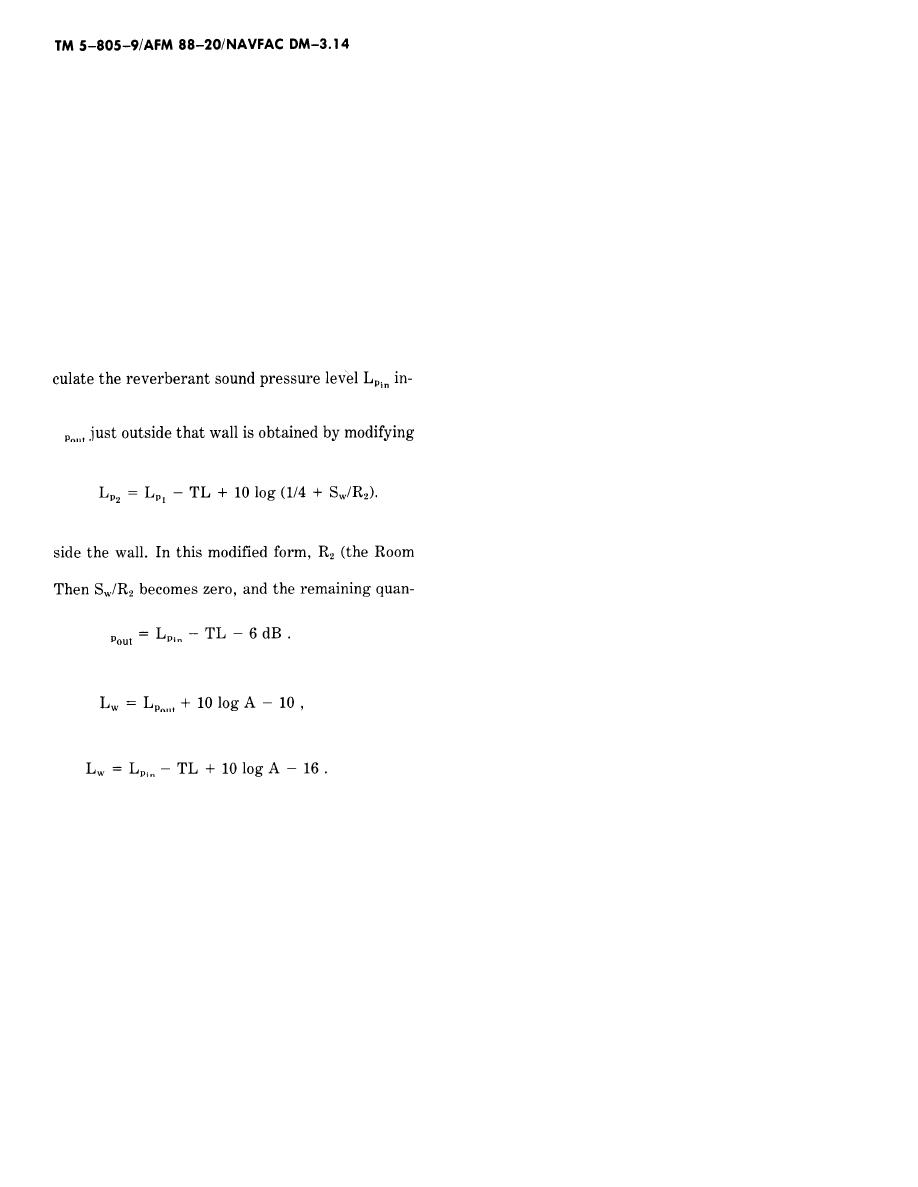
If the engine room is free to radiate sound from all
system for neighborhood acceptance (para 33c of
four of its walls, and if all four walls are of similar
the N&V manual).
construction, the area A in equation 33 should be
the total area of all four walls, and the radiated
32. Noise escape through an outdoor wall.
--
sound is assumed to be transmitted uniformly in all
A lightweight prefabricated garage-like structure
directions. If only one wall is radiating the sound
might be considered as a simple enclosure for a
toward the general direction of the neighbor posi-
small on-base power plant. The transmission loss of
tion, it may be assumed that the sound is trans-
such a structure might be inadequate, however,
mitted uniformly over a horizontal angle that is
and the enclosure would not serve its intended pur-
120 wide, centered at a line that is perpendicular
pose. A calculation procedure is given here for
to the wall under consideration. This procedure
evaluating this situation.
will give a calculated estimate of the SPL at a
a. Noise radiated outdoors by a solid wall. With
neighbor position fr sound transmitted through a
the use of the "room acoustics" material in para-
solid wall whose TL and area are known. Of
graph 53 of the N&V manual and the source data
course, if a lightweight wall does not have suffi-
in paragraphs 27 and 28 of this manual and in
cient TL to meet the need, a heavier wall should be
chapter 7 of the N&V manual, it is possible to cal-
selected.
radiated by a wall containing a door or
b. Noise
side an.
engine room along the wall that radiates
window. The procedure followed in a above for a
noise to
the outdoors. The sound pressure level
solid wall is readily adaptable to a wall containing a
L
door or window or other surface or opening having
equation
54 in the N&V manual. The N&V equa-
a TL different from that of the wall. It is necessary
tion 54
is repeated here:
to calculate the effective TLC of the composite wall
and to use TLC in the procedure above. The TLC of
the composite wall may be determined from one of
This equation is modified to become equation 31
the methods given in paragraph 5-4e of the N&V
below for the case of the sound pressure level out-
manual.
c. Noise radiated from an opening in a wall. An
Constant of the "receiving room") becomes infinite.
opening in an outside wall may be required to per-
mit ventilation of the room or to supply air to an
tity 10 log 1/4 is 6 dB. Thus, equation 31 is:
engine. Noise escaping through that opening might
(3-1)
L
be disturbing to the neighbors. The sound power
level LW of the escaping noise can be calculated
The sound power level LW radiated by this wall is
with the material given in paragraph 722 in the
(from eq. 7-18 in the N&V manual)
N&V manual, and the SPL at the neighbor position
(3-2)
estimated from the tables 63 or 64 distance
2
where A is the area of the radiating wall, in ft.
terms of the N&V manual. If excessive amounts of
Equation 33 combines equations 31 and 3-2:
noise escape through the opening, a dissipative
muffler should be installed in the opening (para
(3-3)
3-4).
This equation must be used carefully. For a large-
d. Noise radiated from the roof of a building.
area wall with a low TL in the low-frequency re-
Noise from inside a building will escape through
gion, it is possible for equation 33 to yield a calcu-
the roof of that building. For a building with a
lated value of sound power level radiated by the
practically flat roof and a 2- to 5-ft.-high parapet
wall that exceeds the sound power level of the
around the edge of thereof, the noise radiated from
source inside the room. This would be unrealistic
the roof has a significant upward directivity effect.
and incorrect. Therefore, when equation 33 is
This results in a lower amount of sound radiated
used, it is necessary to know or to estimate the
horizontally from the roof surface. There are no
PWL of the indoor sound source (or sources) and
measured field data for the directivity effect of
not allow the LW of equation 33 to exceed that
roof-radiated sound, but a reasonable estimate of
value in any octave band. When the PWL of the
this effect is given in table 31. Without a parapet
radiating wall is known, the SPL at any distance of
around the roof, slightly larger amounts of sound
interest can be calculated from equation 61 or ta-
are radiated horizontally; and a sloping room radi-
bles 63 or 64 of the N&V manual. The directivity
ates still higher amounts of sound horizontally.
of the sound radiated from the wall is also a factor.
--
3-2


 Previous Page
Previous Page
